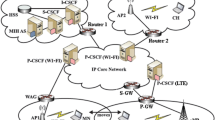Abstract
With the emergence of multimedia applications that have real constraints, ensuring a satisfying quality of service to mobile users presents a big challenge in heterogeneous wireless networks. In such environment, the asymmetry of the available resources as well as user’s mobility can cause offered QoS degradation. In this paper, we propose the use of the Stream Control Transmission Protocol (SCTP) within a QoS adaptive IPTV services in a novel IMS architecture. The multi-homing feature and the partial reliability extension allow improving the network performance and increasing the user satisfaction. In addition, we have proposed an mSCTP based mobility scheme to guarantee service continuity during handover to IPTV users over IMS. The handover decision includes Perceived QoS (PQoS) measurement reflecting the user satisfaction and Media Independent Handover (MIH) information. An analytical study of the time required to perform IPTV adaptation, show that our approach improves the performance by minimizing the delay and maximizing the user satisfaction.











Similar content being viewed by others
References
Argyriou, A. (2005). A novel end to end architecture for H.264 video streaming over the internet. Telecommunication Systems, 28(2), 133–150.
Arnaud, J., Negru, D., Sidibé, M., Pauty, J., & Koumaras, H. (2010). Adaptive IPTV services based on a novel IP multimedia subsystem. Journal of Multimedia Tools and Applications, 55, 333–352.
Camarillo, G., Kantola, R., & Schulzrinne, H. (2003). Evaluation of transport protocols for the session initiation protocol. IEEE Network.
De Marco, G., De Vito, D., Longo, M., & Loreto, S. (2003). SCTP as a transport for SIP: a case study. In The 7th world multiconference on systemics, cybernetics and informatics (SCI 2003).
IEEE 802 21 working Group (2009). IEEE standard for local and metropolitan area networks, part 21: media independent handover. IEEE Std 802.21–802.2008.
Kim, S. T., Koh, S. J., & Kim, Y. J. (2007). Performance of SCTP for IPTV applications. In The 9th international conference on advanced communication technology (ICACT 2007) (pp. 2176–2180).
Koh, S. J., & Hyun, W. (2008). mSIP: extension of SIP for soft handover with bicasting. IEEE Communications Letters, 12(7).
Leu, F. Y. (2009). A novel network mobility handoff scheme using SIP and SCTP for multimedia applications. Journal of Network and Computer Applications, 3(5).
Lopes Filho, E., Hashimoto, G. T., & Rosa, P. F. (2008). An IMS control and access layer PR-SCTP based network. In The 4th international conference on networking and services (ICNS) (pp. 61–66).
Maeda, T., Kozuka, M., & Okabe, Y. (2009). Reliable streaming transmission using PR-SCTP. In Proceedings of the annual international symposium on applications and the internet (SAINT’09) (pp. 278–279).
Molteni, M., & Villari, M. (2002). Using SCTP with partial reliability for MPEG-4 multimedia streaming. In Proceedings of BSDCon Europe 2002.
Rosenberg, J., et al. (2005). The stream control transmission protocol (SCTP) as a transport for the session initiation protocol (SIP). RFC 4168.
Sadhukhan, P., et al. (2011). Hybrid mobility management schemes integrating mobile IP and SIP for seamless invocation of services in all-IP network. Telecommunication Systems.
Sanson, H., Neira, A., Loyola, L., & Matsumoto, M. (2010). PR-SCTP for real time H.264/AVC video streaming. In The 12th international conference on advanced communication technology (ICACT 2010) (pp. 59–63).
Stewart, R., et al. (2007). Stream control transmission protocol. RFC4960.
Stewart, R., et al. (2004). Stream control transmission protocol (SCTP) partial reliability extension. RFC 3758.
Stewart, R., et al. (2007). Stream control transmission protocol (SCTP) dynamic address reconfiguration. RFC5061.
Xu, Ch., Fallon, E., Qiao, Y., Muntean, G., Li, X., & Hanley, A. (2009). Analysis of real-time multimedia transmission over PR-SCTP with failover detection delay and reliability level differential. In The international conference on communication software and networks (ICCSN 2009) (pp. 768–772).
Yang, S., Zhou, H., Qin, Y., & Zhang, H. (2009). SHIP: cross layer mobility management scheme based on session initiation protocol and host identity protocol. Telecommunication Systems, 42, 5–15.
Author information
Authors and Affiliations
Corresponding author
Rights and permissions
About this article
Cite this article
Boussen, S., Arnaud, J., Krief, F. et al. IPTV QoS adaptation for multi-homed mobile terminals in a new IMS based architecture. Telecommun Syst 55, 199–210 (2014). https://doi.org/10.1007/s11235-013-9775-1
Published:
Issue Date:
DOI: https://doi.org/10.1007/s11235-013-9775-1




